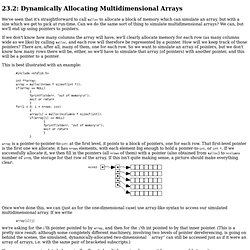

PGM Format Specification. Updated: 27 November 2013 Table Of Contents pgm - Netpbm grayscale image format This program is part of Netpbm.

The PGM format is a lowest common denominator grayscale file format. It is designed to be extremely easy to learn and write programs for. (It's so simple that most people will simply reverse engineer it because it's easier than reading this specification). A PGM image represents a grayscale graphic image. The name "PGM" is an acronym derived from "Portable Gray Map. " One official variant of PGM is the transparency mask. The format definition is as follows. A PGM file consists of a sequence of one or more PGM images. Each PGM image consists of the following: A "magic number" for identifying the file type. Strings starting with "#" may be comments, the same as with PBM. Note that you can use pamdepth to convert between a the format with 1 byte per gray value and the one with 2 bytes per gray value.
All characters referred to herein are encoded in ASCII. 2D Convolution. A 2D convolution can be thought of as replacing each pixel with the weighted sum of its neighbors.

The kernel is another image, usually of smaller size, which contains the weights. The sum of the weights should be 1 (one). If this is not the case, the sum of the weights can be computed during the summation, and used to scale the result. Cycle Counters - FFTW 3.3. 10.3 Cycle Counters FFTW's planner actually executes and times different possible FFT algorithms in order to pick the fastest plan for a given n.

In order to do this in as short a time as possible, however, the timer must have a very high resolution, and to accomplish this we employ the hardware cycle counters that are available on most CPUs. Currently, FFTW supports the cycle counters on x86, PowerPC/POWER, Alpha, UltraSPARC (SPARC v9), IA64, PA-RISC, and MIPS processors. Access to the cycle counters, unfortunately, is a compiler and/or operating-system dependent task, often requiring inline assembly language, and it may be that your compiler is not supported. Free Software. 2D Pre-Stack Depth Migration 2008: Parallel (MPI) 2D pre-stack depth migration, 2D wavefield extrapolation, and 2D Greens function calculation.

All programs make use of WLSQ optimised one-way wavefield extrapolation operators. source code, manual 2D convolution for 3D wavefield extrapolation. 23.2: Dynamically Allocating Multidimensional Arrays. We've seen that it's straightforward to call malloc to allocate a block of memory which can simulate an array, but with a size which we get to pick at run-time.

Can we do the same sort of thing to simulate multidimensional arrays? We can, but we'll end up using pointers to pointers. If we don't know how many columns the array will have, we'll clearly allocate memory for each row (as many columns wide as we like) by calling malloc, and each row will therefore be represented by a pointer. 2D Convolution. 1 Introduction2 Theory3 Algorithms 3.1 simple 3.2 symmetric 2D 3.3 symmetric circle 3.4 symmetric and cache4 Performance5 Conclusion6 Links and References 1 Introduction Convolution is a widely used technique in image and signal processing applications.

Fast algorithm for computing matrix multiplication!!!! Mostly people are using this algorithm to compute matrix multiplication: Code: C #define n 1000int main(){ int a[n][n],b[n][n],c[n][n]; c[0][0]=0; for( i=0;i<n;++i) { for(j=0;j<n;++j) { for(k=0;k<n;++k) { c[i][j] = c[i][j] + a[i][k] * b[k][j] } } } return 0;} In this program( a short algo) , every time we are taking one element of an array to catche and processing for it.

Means At one time cpu reading one element value of a array and b Array and compute and store to c Array. To reading every time elements from array , why we are taking some group of element i.e. C++ - Speed up matrix multiplication. Convolution. Convolution is the most important and fundamental concept in signal processing and analysis.

By using convolution, we can construct the output of system for any arbitrary input signal, if we know the impulse response of system. How is it possible that knowing only impulse response of system can determine the output for any given input signal? We will find out the meaning of convolution. Convolution via the Frequency Domain. Suppose that you despise convolution.

What are you going to do if given an input signal and impulse response, and need to find the resulting output signal? Figure 9-8 provides an answer: transform the two signals into the frequency domain, multiply them, and then transform the result back into the time domain. Peter's Functions for Computer Vision. To use these functions you will need MATLAB and the MATLAB Image Processing Toolbox.

You may also want to refer to the MATLAB documentation and the Image Processing Toolbox documentation Octave Alternatively you can use Octave which is a very good open source alternative to MATLAB. Create structure array - MATLAB. Syntax s = structs = struct(field,value) examples = struct(field1,value1,... ,fieldN,valueN) examples = struct([]) Description s = struct creates a scalar (1-by-1) structure with no fields. example. Separable convolution: Part 2. Back in October I introduced the concept of filter separability. A two-dimensional filter s is said to be separable if it can be written as the convolution of two one-dimensional filters v and h: I said then that "next time" I would explain how to determine whether a given filter is separable.
Well, I guess I got side-tracked, but I'm back on topic now. This question gave me one of earliest opportunities at The MathWorks to wander down to company co-founder Cleve's office and ask for advice. Steve on Image Processing. Contents What is a separable filter? A two-dimensional filter kernel is separable if it can be expressed as the outer product of two vectors. For example, let's look at a Sobel kernel.
2-D convolution - MATLAB. Syntax. Timm's dev blog OpenCV: Equivalent to Matlabs conv2() function. Home > Computer Vision > OpenCV: Equivalent to Matlab’s conv2() function The numerical computing environment Matlab (or e.g. its free alternative GNU Octave) provides a function called conv2 for the two-dimensional convolution of a given matrix with a convolution kernel. While writing some C++ code based upon the free image processing library OpenCV, I found that OpenCV currently offers no equivalent method. Although there is a filter2D() method that implements two-dimensional correlation and that can be used to convolute an image with a given kernel (by flipping that kernel and moving the anchor point to the correct position, as explained on the corresponding OpenCV documentation page), it would be nice to have a method offering the same border handling options as Matlab (“full”, “valid” or “same” convolution), e.g. for comparing results of the same algorithm implemented in both Matlab and C++ using OpenCV.